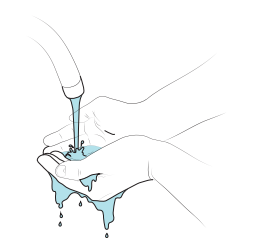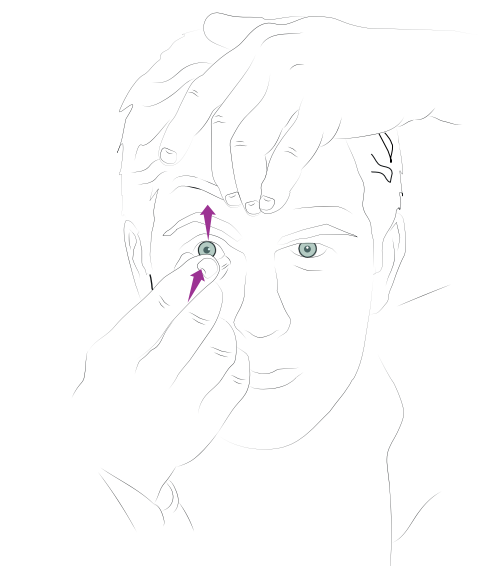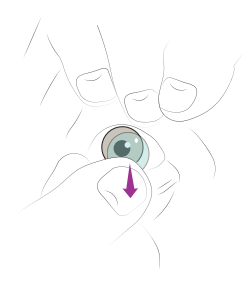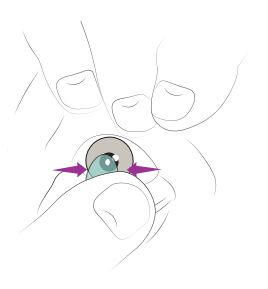
While contact lenses are a great alternative to traditional glasses, offering you a natural look when you want it, there are some special steps you need to take to keep your eyes healthy. Knowing how to correctly clean your contact lenses is just one part of proper contact lens care. You’ll need to know how to put your lenses in correctly and remove them too. Which is why we’re here to help. Read on to learn how to remove contact lenses.
Step by step: removing contact lenses
No matter the type of lenses you wear, you will need to know how to remove them correctly. This is essential to keeping your eyes happy and healthy. And allows you to clean your lenses which is vital for removing debris, dust, and bacteria that can build up as you wear them.
Removing your contact lenses is quick and easy and you don’t need to actually touch your eye if that makes you uncomfortable.
1. Thoroughly wash and dry your hands

Before you do anything, it’s essential to wash your hands with mild, fragrance-free soap and water (for at least 20 seconds). Washing them helps to prevent transferring dirt or bacteria into your eyes. Allow your hands to air dry or use a lint-free towel to avoid getting fabric fibres in your eyes as well.
You may also wish to trim your nails or file them to make sure there are no jagged edges near your eyes.
2. Gently pull apart your eyelids

Use the middle finger of your dominant (or writing) hand to pull your lower lid down. At the same time, use the middle finger of your other hand to pull up your upper eyelid, making sure your eyelashes are pulled back too. This is to create enough space to access your lens without irritating your eye. Ensure your thumb is on the outer side of your eye each time.
3. Look towards your nose and slide the lens

Turn your head so the eye you’re working on is looking slightly towards your nose. With the forefinger of your lower hand, slide the lens sideways towards the outer corner of your eye.
4. Pinch the lens to remove it.

After sliding your lens to the side, you can gently use the thumb and forefinger of your lower hand to pinch the lens and lift it away from your eye. Make sure you use the sides of your finger pads to do so. Do not use your nails as they can damage your lens or accidentally scratch your eye.
5. Repeat for the other eye
Once you’ve removed one lens, if it's a reusable lens clean it using the appropriate solutions, and store it in your lens case. You can then move on and remove the other lens from your other eye.
Other methods for removing contact lenses
The side-pinch method isn’t for everyone and some wearers might struggle to remove their lenses this way or they may be too slippery or feel stuck. If that’s the case, there are a few other methods for removing lenses that you may have more success with.
The ceiling method
Instead of sliding your lens to the side, follow steps 1 and 2, tilt your head down slightly or look up towards the ceiling, and touch your lens with the index finger of your lower hand. Slide the lens down towards your lower lid before pinching and removing it.
The direct pinch method
Another method involves pinching your lens directly off your eye instead. Part your eyelids in the exact same way and look straight in the mirror. Using the pads of your fingers (not the very tips), directly pinch your lenses off of your eye.
The blink method
A very easy method for removing your contact lenses involves not needing to pinch your eye at all. Simply place your finger tips at the outer corner of your eye and gently separate your eye lids at the outer corners. Look towards your nose and blink and your lens should easily remove from your eye. Just make sure you don’t drop them.
How to choose the right contact lenses that fit your lifestyle
Contact lens care is an important part of being a contacts wearer. Wearing, removing, and cleaning are all vital to your eye health. But we know that those extra steps might not be for everyone. Thankfully, there are multiple different options for lenses to suit any preference including disposable daily types that don’t require cleaning and types that can be worn for multiple days without removing. Check out our useful guide to help you choose the right contact lenses that fit your lifestyle.








